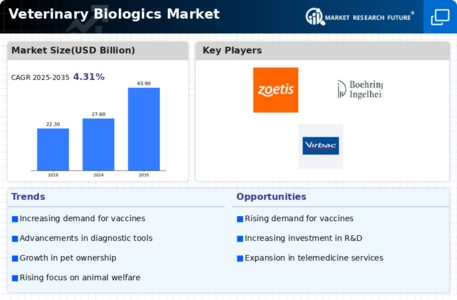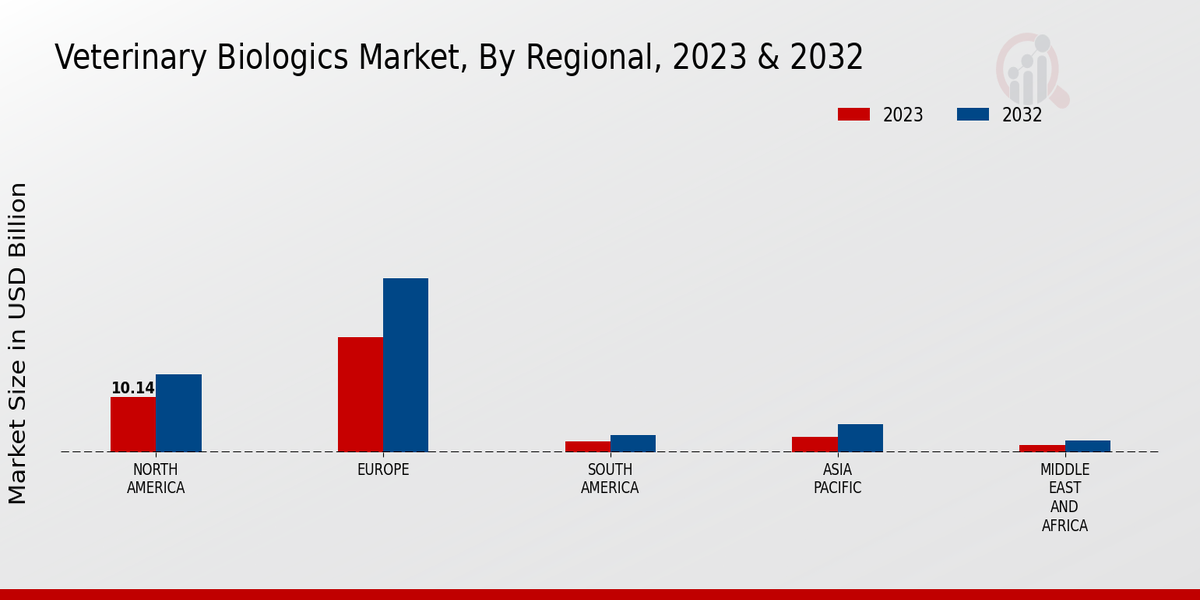Market Growth Projections
The Global Veterinary Biologics Market Industry is projected to experience substantial growth over the next decade, with estimates suggesting a market size of 43.9 USD Billion by 2035. This growth trajectory reflects a compound annual growth rate (CAGR) of 4.31% from 2025 to 2035, indicating a steady increase in demand for veterinary biologics. Factors contributing to this growth include advancements in technology, rising awareness of animal health, and supportive regulatory environments. As the market evolves, stakeholders are likely to focus on innovation and collaboration to meet the changing needs of the industry, ensuring a vibrant future for the Global Veterinary Biologics Market Industry.
Global Trade and Export Opportunities
The Global Veterinary Biologics Market Industry benefits from expanding trade and export opportunities, particularly as countries seek to enhance their animal health standards. Increased globalization has led to a more interconnected market, allowing for the exchange of veterinary biologics across borders. Countries with advanced research capabilities are exporting innovative products to regions with emerging markets, thereby fostering growth. This trend not only enhances the availability of veterinary biologics but also encourages collaboration between countries in addressing animal health challenges. As international trade continues to evolve, the Global Veterinary Biologics Market Industry is likely to experience sustained growth driven by these opportunities.
Technological Advancements in Biologics
Technological innovations play a pivotal role in shaping the Global Veterinary Biologics Market Industry. Advances in biotechnology, such as recombinant DNA technology and monoclonal antibody production, are enhancing the efficacy and safety of veterinary biologics. These innovations not only improve the effectiveness of vaccines and therapeutics but also streamline production processes, reducing costs and time to market. As a result, the market is expected to witness a compound annual growth rate (CAGR) of 4.31% from 2025 to 2035. This growth is indicative of the industry's adaptability to new technologies, which could lead to more effective solutions for animal health challenges.
Regulatory Support for Veterinary Biologics
Regulatory frameworks are increasingly supportive of the Global Veterinary Biologics Market Industry, facilitating the approval and commercialization of new products. Governments worldwide are recognizing the importance of veterinary biologics in ensuring animal health and food safety. Streamlined approval processes and guidelines for the development of vaccines and therapeutics are encouraging investment in research and development. This regulatory environment not only fosters innovation but also enhances consumer confidence in the safety and efficacy of veterinary biologics. As the market evolves, regulatory support is likely to play a crucial role in maintaining the momentum of growth within the Global Veterinary Biologics Market Industry.
Increasing Demand for Animal Health Products
The Global Veterinary Biologics Market Industry experiences a notable surge in demand for animal health products, driven by a growing awareness of animal welfare and the importance of preventive healthcare. This trend is particularly evident in regions with expanding livestock industries, where veterinarians and farmers increasingly prioritize vaccination and disease prevention. The market is projected to reach 27.6 USD Billion in 2024, reflecting a robust commitment to enhancing animal health. As consumers become more conscious of food safety and quality, the demand for biologics that ensure healthy livestock is likely to rise, further propelling the growth of the Global Veterinary Biologics Market Industry.
Rising Pet Ownership and Companion Animal Care
The Global Veterinary Biologics Market Industry is significantly influenced by the rising trend of pet ownership, particularly in urban areas. As more households adopt pets, there is an increasing demand for veterinary services and biologics tailored to companion animals. Pet owners are becoming more proactive about their pets' health, seeking vaccinations and preventive care to ensure longevity and quality of life. This trend is expected to contribute to the market's growth, with projections indicating a potential market size of 43.9 USD Billion by 2035. The focus on companion animal health is likely to drive innovations in biologics, further enhancing the offerings within the Global Veterinary Biologics Market Industry.














